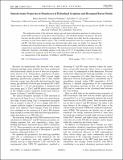Optoelectronic Properties in Monolayers of Hybridized Graphene and Hexagonal Boron Nitride
Author(s)
Bernardi, Marco; Palummo, Maurizia; Grossman, Jeffrey C.
DownloadBernardi-2012-Optoelectronic Properties in Monolayers of Hybridized Graphene.pdf (1.658Mb)
PUBLISHER_POLICY
Publisher Policy
Article is made available in accordance with the publisher's policy and may be subject to US copyright law. Please refer to the publisher's site for terms of use.
Terms of use
Metadata
Show full item recordAbstract
We explain the nature of the electronic energy gap and optical absorption spectrum of carbon–boron-nitride (CBN) monolayers using density functional theory, GW and Bethe-Salpeter calculations. The band structure and the optical absorption are regulated by the C domain size rather than the composition (as customary for bulk semiconductor alloys). The C and BN quasiparticle states lie at separate energy for C and BN, with little mixing for energies near the band edge where states are chiefly C in character. The resulting optical absorption spectra show two distinct peaks whose energy and relative intensity vary with composition in agreement with the experiment. The monolayers present strongly bound excitons localized within the C domains, with binding energies of the order of 0.5–1.5 eV dependent on the C domain size. The optoelectronic properties result from the overall monolayer band structure, and cannot be understood as a superposition of the properties of bulklike C and BN domains.
Date issued
2012-06Department
Massachusetts Institute of Technology. Department of Materials Science and EngineeringJournal
Physical Review Letters
Publisher
American Physical Society
Citation
Bernardi, Marco, Maurizia Palummo, and Jeffrey Grossman. “Optoelectronic Properties in Monolayers of Hybridized Graphene and Hexagonal Boron Nitride.” Physical Review Letters 108.22 (2012). © 2012 American Physical Society
Version: Final published version
ISSN
0031-9007
1079-7114